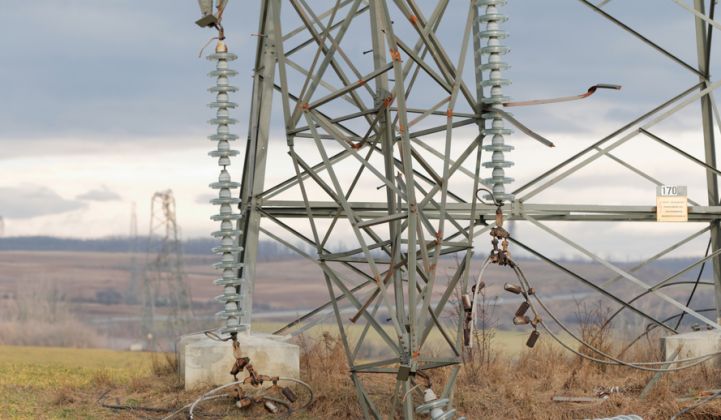It’s easy to make the case that America’s electricity industry is stuck in the past. But it’s impossible to suggest a new energy future isn’t already on its way.
Our electricity landscape is changing dramatically. Texas, the birthplace of the U.S. oil boom a century ago, now produces more wind power than most countries. New York is testing microgrids and bringing new competition to electricity markets. Illinois is modernizing the electric grid, empowering people to control their energy use and reduce their electricity bills through smart-meter data. Homes are generating -- and will soon be storing -- their own electricity. Electric vehicles that charge in three hours and accelerate like a sports car are coming to more garages.
These developments are exciting and potentially very beneficial to the environment, as a smarter grid and more renewable energy reduce our reliance on coal. But they upset some old-school utilities and a 100-year-old utility business model predicated on the idea that selling more electricity is the only route to profit -- and that how we get that electricity has no consequences.
Not surprisingly, some are resisting change. Exhibit A: FirstEnergy.
The Akron, Ohio utility owns power plants and transmission lines throughout the Northeast and Midwest and currently appears to be campaigning for poster child of the 20th century. Last year, FirstEnergy pushed Ohio to become the first state to gut its successful clean energy standards by arguing efficiency programs would raise electricity rates. However, in previous filings before the Public Utilities Commission of Ohio (PUCO), the company admitted the initiatives saved families millions.
In more honest (but less public) presentations to investors, the company's executives revealed low-cost, clean energy efforts were interfering with sales and profits.
FirstEnergy is also trying to block a new competitor -- demand response -- which pays people to conserve energy when the electric grid is stressed. This low-cost, zero-carbon energy resource saved customers in the mid-Atlantic region $11.8 billion in 2013. But it’s a threat to companies like FirstEnergy that see demand as something that can only be met with more generation -- its generation.
FirstEnergy is now attempting to get demand response kicked out of the PJM (mid-Atlantic) energy market. I suppose if you can’t beat your competition, maybe you can just eliminate it.
Most recently, the company is making headlines because its old power plants are losing money and FirstEnergy wants its customers to pay for a $3 billion bailout to prop it up.
For the record, FirstEnergy is among a small group of outliers. Most utilities are already embracing change, and many are truly pushing for a modern system. But FirstEnergy’s behavior is remarkably backward and protectionist.
And its bailout proposal is the icing on the cake. The company wants regulators in Ohio to approve a non-competitive purchase agreement whereby its sister company would buy the output of another subsidiary’s three old coal-fired power plants and a nuclear reactor.
The utility’s proposal would ensure a substantial portion of FirstEnergy’s power comes from these plants for 15 years -- regardless of their profitability or an evolving energy market that’s already trending toward cleaner energy resources. Customers, moreover, would bear the operational risk and pay the subsidy whether the plants deliver power or not.
Adding insult to injury, those who choose to buy clean energy would also be forced to buy FirstEnergy’s coal energy as well -- unnecessarily paying twice for power.
Even FirstEnergy admits its proposal will cost customers more than $400 million during the three-year period of the proposed rate increase. Although the utility suggests benefits will slowly rise, the Ohio Consumers Council found FirstEnergy’s proposal would cost about $3 billion over 15 years.
FirstEnergy’s efforts demonstrate just how much electricity politics have changed. Now, conservationists are arguing for market competition while utilities struggle to protect their monopolies. Environmentalists are seeking a level playing field, while power companies ask for bailouts.
Moreover, the FirstEnergy saga raises fundamental questions about the future of the power industry. Will utilities redefine themselves for the future, or will they lobby to restore past monopolies and subsidize old technologies? And how willing will local officials be to help them slow down progress? How the PUCO responds to FirstEnergy’s bailout proposal will give us some answers in Ohio.
No doubt FirstEnergy’s attacks against the changing energy industry will continue or even accelerate. The company has gone “all in,” and it’s unlikely to change course now. Yet its tactics and motives should be seen for what they are: a defense of the past and a fight against the future.
***
Dick Munson is EDF's Director, Midwest Clean Energy, where he works to advance the use of clean energy in Illinois, Ohio, and Pennsylvania. Dick currently focuses on creating new financing opportunities for efficiency, ensuring smart meters provide the real-time data that will enable consumers to cut energy and pollution, and building the business case for efficiency within commercial buildings. He is also the author of From Edison to Enron, a history of the electricity industry.



